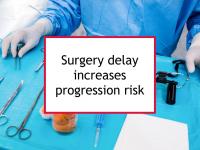Excessive delays between breast cancer treatment steps have been linked to less favorable outcomes in multiple studies, especially for women with aggressive types such as triple negative (ER-/PR-/HER2-) disease. Now a new study has reported on the likelihood of delays between diagnosis and breast surgery to cause tumor upstaging, thereby increasing risk of breast cancer progression.
Why a delay between biopsy and surgery matters
In cases of indolent disease, small breast tumors could potentially remain untreated for extended periods of time without affecting prognosis. In any case, tumors of newly-diagnosed women typically have been growing for several years before being detected. Why should a delay of a few weeks between biopsy and surgery matter?
In fact, the process of diagnosis appears to cause important changes. Physically disturbing a tumor has been reported to increase its metastatic potential. For example, breast surgery has been shown to induce modifications in the expression of genes implicated in increased cancer cell proliferation and motility (ability to move), thereby allowing such cells to escape into circulation. Surgical biopsy could also have such a result. Needle biopsies involving taking multiple tissue samples could cause the required degree of damage to tumor tissue as well.
Another possible source of worse outcomes associated with treatment delays is the potential for needle track seeding. Needle track seeding occurs when breast cancer cells are deposited along the path of a biopsy needle as it is withdrawn from the breast. Evidence suggests that such seeding does occur 20% to 50% of the time. However, most breast cancer cells moved by biopsy needles do not survive — studies that have examined the question as to whether such seeding influences breast cancer survival have been reassuring. However, even if unlikely, the potential for needle track seeding to result in metastasis is another reason that the next step in treatment after biopsy should occur in a timely manner.
Latest research links delays to tumor upstaging and growth
The study referenced above was designed to investigate risks of tumor upstaging and nodal spread while awaiting surgery after a diagnosis of breast cancer. The authors also estimated waiting period tumor growth rates. To conduct the study, the authors analyzed data from the American College of Surgeons' National Cancer Database (NCDB). The study included 1,018,219 patients with nonmetastatic disease treated between 2010 and 2020 who underwent surgery as first treatment. Patients who had neoadjuvant therapy, had surgery more than 180 days after diagnosis, had previously been diagnosed with other cancers, or were diagnosed with LCIS or inflammatory breast cancer (IBC) were excluded.
The average interval between diagnosis and surgery was 38.5 days; 10.1% of patients had an interval under 16 days. After surgery, 11.5% of the patients had tumor upstaging (increasing the T stage) and 14.1% had nodal upstaging (increasing the N stage).
For every 30-day interval between diagnosis and surgery, the adjusted odds ratio (OR) for tumor upstaging was 1.11 for ductal carcinoma in situ (DCIS). That is to say, for every 30-day increment, there was an 11% increased likelihood of upstaging. The OR was 1.13 for cT1 (clinical stage T1) and 1.18 for cT2 tumors. In other words, the higher the pre-surgery clinical stage, the greater the likelihood that it would be upstaged as a result of a delay in surgery.
At 1.21, the triple negative breast cancer adjusted 30-day upstaging OR was higher than the 1.13 hormone receptor positive (ER+/PR+) OR and the 1.09 human epidermal growth factor 2-positive (HER2+) OR. The more aggressive the breast cancer type, the greater the likelihood of upstaging. Patients who were cN0 (lymph node negative based on imaging or clinical exam before surgery) had an adjusted 30-day OR for upstaging to node-positive of 1.07.
The number of 30-day intervals it took for cT1a, cT1b, cT1c, and cT2 tumors to grow 1 mm was found to be 3.95, 2.63, 2.27, and 1.92, respectively. Tumor growth was faster in triple negative compared to HER2+ or ER+/PR+ tumors.
The authors conclude that longer delays risk greater upstaging and nodal spread, a finding that could explain the association with higher disease-specific and overall mortality found in previous studies. Larger and triple negative tumors have higher likelihoods of delay-induced upstaging and tumor growth rates, indicating that preoperative delays have worse outcomes in these patients, according to the authors.
Please see the treatment delays tag for more information.
